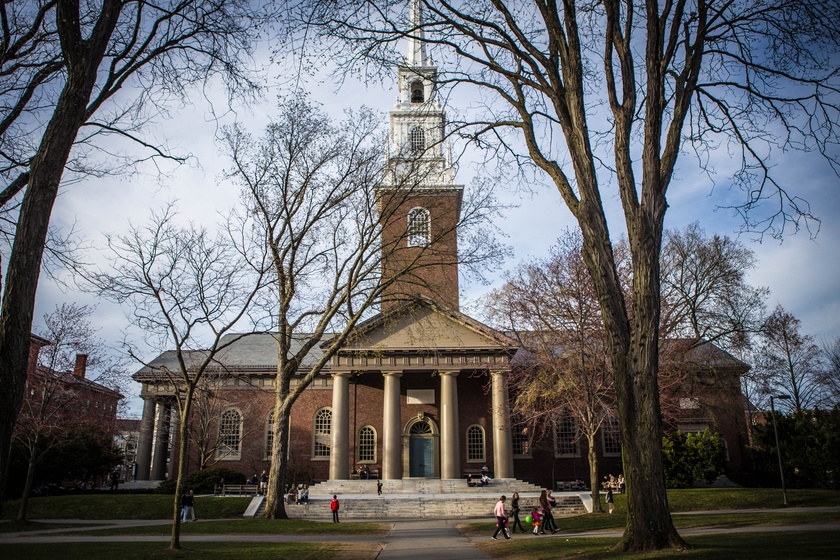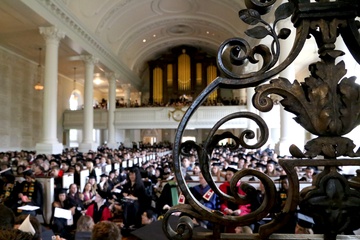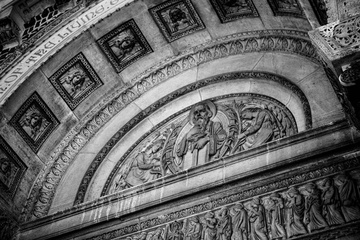Between 8:40 and 8:45 a.m., students and community members pack themselves into the pews of Memorial Church’s Appleton Chapel. Some students rush in at the last minute with wet or uncombed hair. They’re here for morning prayer, a tradition that stretches back almost 400 years to the College’s founding. Yet this morning’s service bears little resemblance to its original form. Its evolution mirrors the College’s gradual response to a student body with changing demands.
In Harvard’s early years, mandatory morning services and evening services were held in small groups in tutors’ chambers. Later in the 17th century, the college held prayer gatherings for the entire student body, led by the president and his close affiliates.
In those days, undergraduate attendance was no joke. “Any undergraduate comes tardy to prayers (without reasons allowed by the president or tutor),” stated the College’s Board of Overseers, “he shall be fined two-pence. And if he be absent from prayers without reasons as aforesaid, he shall be fined four-pence each time.”
This strict policy towards morning prayer attendance was partly justified by the College’s founding emphasis on religious education. However, early Harvard presidents saw another purpose towards compulsory attendance—it was a way to maintain order on campus. They reasoned that churchgoing students were less likely to commit crimes. And they kept those who did attend services on their toes: An 1883 Crimson article cites records of three students “publickly admonished in The Hall for drinking rum (forbidden by the college laws) in the college, and for making disorderly noises in the college at or near midnight.”
A century later, students were relieved when the administration finally began to rethink its policies. President Charles W. Eliot observed no “moral or disciplinary relapse” when morning prayer was suspended for five months in the 1870s for repairs on Appleton Chapel, the predecessor of Memorial Church. He was receptive to the idea of making attendance voluntary, and helped student petitioners attain their desired policy change. By 1886, morning prayer attendance was no longer mandatory.
Reverend Francis G. Peabody, the Plummer Professor of Christian Morals at the time of the change, supported Eliot’s decision. Conducting compulsory services, he said, reminded him of his time spent preaching at the state prison.
Even with optional services, the debate over the role of religion on campus wasn’t finished. It flared up again in the 1920s and 30s, sparked by the construction of Memorial Church. By this time, diversity at Harvard was on the rise, and many opposed the idea of having only a Protestant church on campus as opposed to an interdenominational space. Others believed it was important to have a Protestant chuch as a recognition of Harvard’s religious history.
Further, Memorial Church was built to commemorate the lives of students who passed away during World War I. Some alumni wrote to complain that they would rather have a memorial swimming pool than a memorial church.
Tradition ultimately prevailed: Memorial Church was built as, and remains, a Protestant space of worship. Yet in the hundred years of its existence, its clergy have recognized the importance of Harvard’s growing diversity. This can be seen in the church’s selection of morning prayer speakers: “We’ve been really making an effort to have people come speak from a wide range of backgrounds,” Memorial Church Ministry Fellow Alanna Copenhaver says. These range from Harvard professors, to union workers, to longtime church attendees.
And even Harvard students. The old practice of publicly shaming students during morning prayer is long gone: Students are now encouraged to share their stories. This practice isn’t meant to solicit public admonishment, but to inspire listeners. Copenhaver describes services as “a space where we meet on a daily basis to reflect on our shared humanity.”
This fits nicely with a common saying among Memorial Church staff: “Everyone may not belong to Mem Church, but Mem Church belongs to everyone.”
Balancing tradition and religious inclusion remains different, though. “We have a lot of conversations about how to navigate that,” Copenhaver says. That’s a very live conversation, not just about morning prayer, but also Memorial Church in general.”
“[Harvard is] really rooted in tradition,” she concludes. “But also open to change.”





